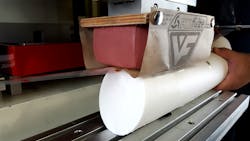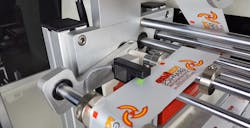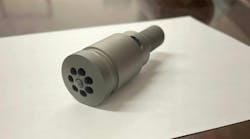It can be difficult to permanently adhere labels to parts made from LSE polyolefins, such as PP and PE. The ability to permanently attach safety labels is critical, and, if those labels fail, consumers can be exposed to danger and manufacturers to liability. Manufacturers of labeled parts would only guarantee labels for two to three years of in-the-field use, according to Polyfuze Graphics, which recently produced a white paper about permanent safety labels for durable goods.
Polyfuze Graphics is a subsidiary of Mold In Graphic Systems, which has offered the Polyfuze graphic permanent labeling technology since 2012. Instead of sticking labels to the part surface, Polyfuze graphic labels fuse with the plastic. Polyfuze graphic labels look similar to vinyl stickers or in-mold labels, but they are pigmented plastic printed on a carrier film.
“What happens is, through the use of heat, we reach the melt temperature of the plastic graphic; we reach the melt temperature of the plastic part, and because the two are the same material, they fuse together and become one piece of plastic,” said Jason Brownell, senior director and brand specialist with Polyfuze Graphics. Labels are available in multiple colors, guaranteed for the lifetime of the part they are applied to and can be recycled with the part, the company said.
When used on a standard heat-stamping machine, Polyfuze’s graphic labels have different requirements than traditional adhesive-based heat transfers. For example, the company said a 4-inch-by-5-inch adhesive-based heat transfer requires about 500 pounds per square inch (psi) of pressure and a temperature of about 300 degrees Fahrenheit. In contrast, applying a Polyfuze graphic label using the same machine would require a temperature of about 450 degrees Fahrenheit and only 75 psi of pressure.
In addition to working with standard heat-stamping machines, the company has developed its new VersaFlex system to allow its labels to work with a different style of heat-transfer machine.
“The machine we use at our facility is made by AutoTran Inc.,” said Marty Mares, CEO of Polyfuze Graphics. “It operates like a pad-print machine, but instead of the silicone ‘loaf’ touching an ink pad, it contacts a heating element. Heat is then transferred to the parts and labels, which causes them to fuse together.”
The VersaFlex system combines the Polyfuze graphic labels with a flexible die/heating element assembly attached to a flexible drape. The drape wraps around the silicone loaf of the machine. The die/heating assembly is made from a special material that transfers heat more efficiently than the machine’s silicone loaf can.
The machine uses a robotic arm to move the die/heating assembly into contact with a heated plate. The die/heating assembly quickly absorbs the heat and is then positioned above a label aligned with a plastic part. The automated system lowers the die/heating assembly, which melts the skin of the plastic part and the label, fusing them permanently. The AutoTran machine also automatically advances the roll and indexes the next label. Polyfuze Graphics has posted a video demonstrating the technology at www.polyfuze.com/videos.
Other systems using metal tools and a standard heat-stamping machine require more force and can structurally damage the walls of hollow parts, or cause the parts to bend and the label to not affix properly. Because it works at lower pressures and uses a soft die/heating element assembly to contact the part and the machine’s silicone loaf applies the force, the VersaFlex system can bond Polyfuze graphic labels to hollow blow molded, injection molded, thermoformed and rotomolded parts that previously were difficult to work with, the company said. Using the VersaFlex system, Polyfuze graphic labels also can be successfully applied to parts with curved surfaces.
Mares said other equipment manufacturers have shown an interest in making machines for use with the technology, and Polyfuze Graphics is working closely with them during their development process to ensure their equipment is compatible with the VersaFlex system.
Polyfuze Graphics and Mold In Graphic Systems were scheduled to unveil the VersaFlex technology during an open house Oct. 11 in Clarkdale, Ariz.
Bruce Geiselman, senior reporter
Polyfuze Graphics Corp. Inc., Clarkdale, Ariz., 928-634-8888, www.polyfuze.com







